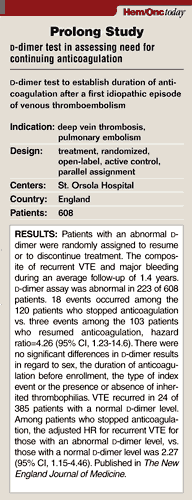Abnormal D-dimer after ending anticoagulation raised risk of recurrent VTE
Fifteen percent of patients who stopped anticoagulation experienced VTE events compared with 3% of patients who resumed anticoagulation.
Patients with an abnormal D-dimer level one month following the discontinuation of anticoagulation therapy had a significant incidence of recurrent venous thromboembolism, and resuming anticoagulation could reduce this risk, according to a phase-4 study.
“Patients with an abnormal D-dimer test who resumed anticoagulation had a significantly lower combined incidence of recurrent VTE and bleeding than did those who did not resume anticoagulation,” said Gualtiero Palareti, MD, from the S. Orsola-Malpighi University Hospital in Bologna, Italy. “Patients with a normal D-dimer level did not resume anticoagulation,” he said.
The optimal course of anticoagulation in patients with normal D-dimer levels has not been clearly established, the researchers reported in The New England Journal of Medicine.
The optimal duration of oral anticoagulation in patients with idiopathic venous thromboembolism is uncertain, according to the study. The testing of D-dimer might play a role in the assessment of the need for prolonged anticoagulation.
Palareti and colleagues launched the Prolong study: D-dimer test to establish the duration of anticoagulation after a first idiopathic episode of venous thromboembolism. They performed D-dimer testing one month after the discontinuation of anticoagulation in patients with a first unprovoked proximal deep-vein thrombosis or pulmonary embolism who had received vitamin K antagonist for at least three months.
 Patients with a normal D-dimer level did not resume anticoagulation, whereas those with an abnormal D-dimer were randomly assigned either to resume or to discontinue treatment. The study outcome was the composite of recurrent VTE and major bleeding during an average follow-up of 1.4 years.
Patients with a normal D-dimer level did not resume anticoagulation, whereas those with an abnormal D-dimer were randomly assigned either to resume or to discontinue treatment. The study outcome was the composite of recurrent VTE and major bleeding during an average follow-up of 1.4 years.
The D-dimer assay was abnormal in 223 of 608 patients. A total of 18 events occurred among the 120 patients who stopped anticoagulation compared with three events among the 103 patients who resumed anticoagulation, for an adjusted hazard ratio of 4.26 (95% CI, 1.23-14.6).
There were no significant differences in D-dimer results in regard to sex, the duration of anticoagulation before enrollment, the type of index event or the presence or absence of inherited thrombophilias.
VTE recurred in 24 of 385 patients with a normal D-dimer level. Among patients who stopped anticoagulation, the adjusted hazard ratio for recurrent VTE for those with an abnormal D-dimer level, compared with those with a normal D-dimer level, was 2.27 (95% CI, 1.15-4.46).
Patients with an abnormal D-dimer were significantly older than those with a normal D-dimer level. Although this result is in line with findings of other reports, it also highlights the hypercoagulability and increased risk of VTE in the elderly. – by Rebekah Cintolo
For more information:
- Palareti G, Cosmi B, Legnani C, et al. D-dimer testing to determine the duration of anticoagulation therapy. N Engl J Med. 2006;355:1780-1789.
